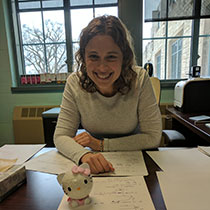Faculty Spotlight: Danna E. Freedman

By Irena Garic
Professor Danna E. Freedman received her A.B. from Harvard University and her PhD from University of California, Berkeley. After completing postdoctoral research at Massachusetts Institute of Technology, she joined the Chemistry Department in 2012. She will be promoted to Professor in Fall. Research in the Freedman Group focuses on applying inorganic chemistry to challenges in physics, with specific emphasis on quantum information science, magnetic materials, and emergent phenomena. Some notable research accomplishments of the Freedman lab include the observation of millisecond coherence times in molecular qubit candidates, and creating the first iron-bismuth bond in the solid-state.
What Chemistry class / professor did you enjoy the most as an undergraduate or graduate student and why?
My inorganic chemistry class was co-taught by Bill Klemperer, a spectroscopist, and Dick Holm a synthetic inorganic chemist. I cannot imagine two less similar teaching styles or humans. Prof. Klemperer lectured while waving around a giant wooden pointer stick, and would accidentally swipe at the entire front row while enthusiastically describing the beauty of wave functions, while Prof. Holm was more gruff and methodical in building up a conception of electronic structure through orbitals. It was a fantastic class that covered the breadth of inorganic chemistry from two disconnected starting points.
What are your current research interests?
We are exploiting the structural precision and atomic level of control inherent in molecular chemistry for quantum information science. Synthetic chemistry confers precise placement of every atom within a system enabling us to construction quantum technologies from the bottom-up. Right now we are working on integrating a molecular approach to quantum information science with established read-out approaches. This could lead to a new generation of “designer qubits” whereby each qubit is tailored for a different application, for example quantum sensing or quantum communications.
What are some potential applications for the work that you’re doing?
One application for quantum information science is quantum sensing, in which the sensitivity of quantum objects to the enlivenment is exploited for sensing. A long term goal of this field is to enable technologies such as single molecule magnetic resonance where a quantum sensor would map out every proton in a single molecule such as a protein. Moving from the ensemble level down to the single molecule would be transformative for our understanding of science.
What is the best part about being at the Northwestern University?
Without question the students and postdocs. I am so lucky to get to work with some of the most creative, engaged, and curious scientists and to have a role in their development as scientists. Beyond people, Northwestern’s exceptional facilities and its proximity to Argonne accelerated our research progress and spurred new research directions.
Do you have any advice for female researchers considering a career in academia?
I love my job, I love working with a team of engaged students and postdocs to create new science. I benefited so much from the support, advocacy and mentorship of women senior to me. Some notable examples include the former chair of physics Heidi Schellman and a visiting female speaker, Melanie Sanford giving me teaching advice that transformed my approach to teaching general chemistry; Sossina Haile finding awards to nominate me for the second she arrived on campus; Monica Olvera de la Cruz brought the MRSEC seed program to my attention a couple of months before I started at Northwestern; and Teresa Woodruff and Carole LaBonne are constant sources of advice and advocacy. Seek out mentorship and support, and provide similar support to those who follow you.
What is one thing not on your CV that you would like us to know?
This is where you register to vote by mail: https://www.cookcountyclerk.com/agency/vote-mail.
What is the first thing you will do after COVID-19 pandemic is over?
Take my son to see his grandparents.
